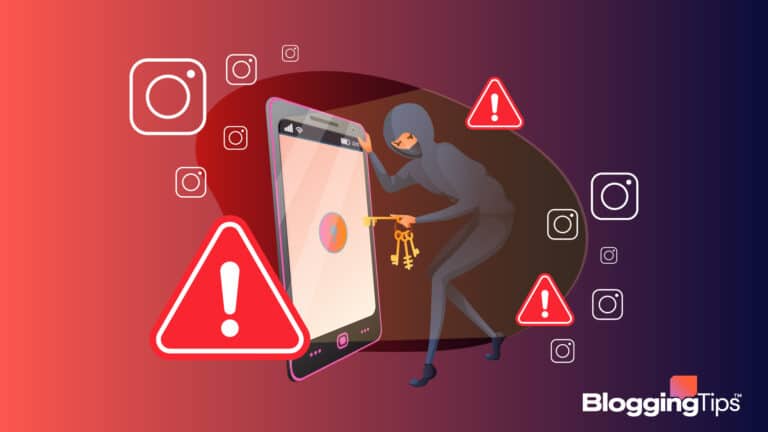If you’re making YouTube videos where you show your face or need to capture footage for content such as sports vlogs or food reviews, then image quality will be a big factor in creating an entertaining experience and attracting a bigger audience.
While you could improve your video quality with tricks like editing, high-quality footage mostly depends on having the right video camera.
That doesn’t mean you should go for the most expensive professional camera right away, however. Instead, you need to consider your needs and options to find the right product.
So, what is the best camera for YouTube in 2023, considering the current quality standards? That’s what we’ll go over in this article, so stick around!
At a Glance
The best camera for YouTube is different from one person to another, as it ultimately depends on what you’re looking for.
If you need an all-around powerful camera with a rich history and legacy, there’s the Canon PowerShot G7 X Mark III. Need something a little smaller for filming on the go? Check out the Sony ZV-1. Or, if you’re looking to film during physical outdoor activities or sports, you have the fan-favourite GoPro HERO 11.
Check out this handy comparison table here.
| Camera | Resolution | Max video resolution | Streaming | Weight |
| Canon PowerShot G7 X Mark III | 20.1 MP | 5,472 x 3,648 | Enabled via Wi-Fi | 10 oz (300 grams) |
| Blackmagic Pocket Cinema Camera | 21.2 MP | 4,096 x 2,160 | Enabled via USB-C | 24 oz (680 grams) |
| Sony ZV-1 | 20.1 MP | 4K HD | Built-in, also possibly via micro USB | 9.5 oz (267 g) |
| Panasonic Lumix GH6 | 25.2 MP | 5,776 x 4,336 | Unavailable | 1.8 lb (823 g) with the battery, 1.63 lb (739 g) without |
| GoPro HERO 11 Black | 27.13 MP | 5,321 x 4,648 | Enabled | 5.43 oz (154 g) |
| Nikon Z 30 | 20.9 MP | 3,840 × 2,160 | Enabled via USB-C | 12.4 oz. (350 g) |
What Is the Best YouTube Camera in 2023?
There are numerous candidates that could qualify as the best camera for YouTube. We couldn’t possibly include all the good products in this list without making it long. So, we’ve tried the most popular and highly recommended options to come up with this list, even though a lot of honorable mentions fell short of making the cut.
So, without further ado, here are the best cameras for recording YouTube videos in 2023.
1. Canon PowerShot G7 X Mark III
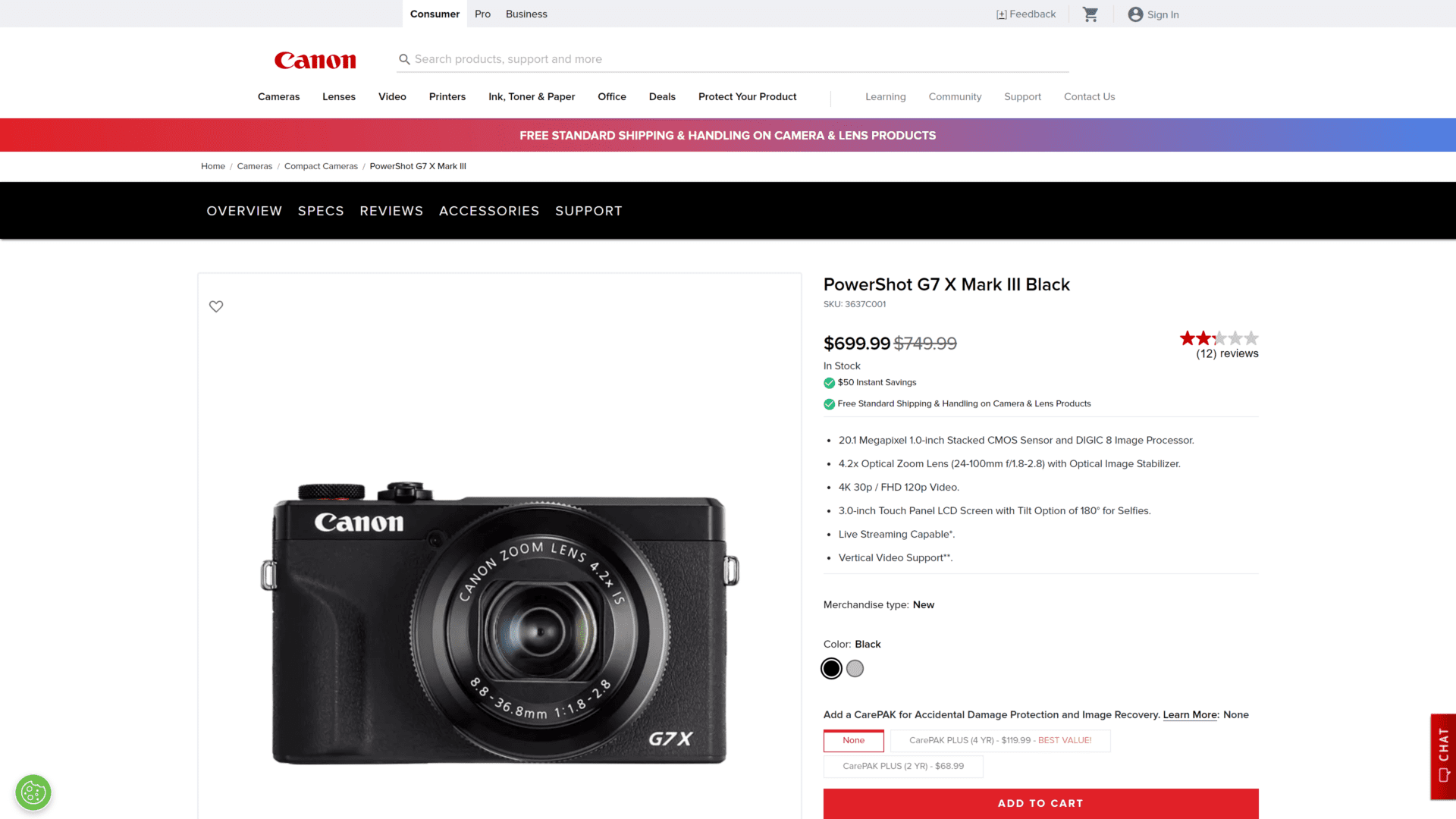
Specifications
- Resolution: 20.1 MP
- Max video resolution: 5,472 x 3,648
- Audio capturing: 3.5mm mic port
- Monitor: 3″ LCD touchscreen
- Streaming: Enabled via Wi-Fi
- Dimensions: 4.13 x 2.4 x 1.63 inches (105 x 60.9 x 41.4 mm)
- Weight: 10 oz (300 grams)
Overview
If you’re into watching YouTube vlogs, chances are you’ve seen vloggers that are using either the Canon PowerShot G7 X Mark III or its predecessor, the G7 X Mark II. And while both are great vlogging cameras, the newer G7 X Mark III offers more features than its older counterpart.
For starters, Canon added a new shooting mode: the Raw Burst, which captures at 30 FPS. It also has an improved 1-inch, 20.1 MP sensor. They’ve also improved the image processor, opting for the newer DIGIC 8.
In terms of video shooting capabilities, the G7 X Mark III has 4K Ultra HD recording paired with a 3.5mm mic input. However, no improvements were made to the lens in the new model; like its predecessor, the Mark III uses a 24-100mm f/1.8-2.8 lens.
Canon designed the body of the G7 X Mark III to sit comfortably in one’s hand, with plenty of rubber pieces for support. Also, the Mark III’s flip-up LCD screen is useful for vloggers.
The camera has practical four-dial controls around the body, Wi-Fi and NFC, and a USB-C port to charge its respectable 235-shot battery.
2. Blackmagic Pocket Cinema Camera

Specifications
- Resolution: 21.2 MP
- Max video resolution: 4,096 x 2,160
- Audio capturing: 3.5mm mic port
- Monitor: 5″ LCD touchscreen
- Streaming: Enabled via USB-C
- Dimensions: 7.01 x 3.37 x 3.78 inches (178 x 85 x 96 mm)
- Weight: 24 oz (680 grams)
Overview
At first glance, the Blackmagic Pocket Cinema camera’s retro design might make you think that it’s an old device with limited capabilities. However, that couldn’t be further from the truth.
The Blackmagic Pocket Cinema Camera comes with a modern 5-inch LCD touchscreen with a resolution of 1920 x 1080 pixels.
And although the design looks quite dated, the build quality makes up for the camera’s looks. The frame is built out of fiberglass and combi-polycarbonate, which gives the camera a sturdy and weighted feel. Also, the design isn’t too angular at the corners; hence, the camera has a comfortable hold for people with small or big hands.
A downside to the Blackmagic Pocket Cinema Camera is that it doesn’t have auto-focus like Nikon and Canon cameras. However, it makes up for this by adding a colored outline on the monitor when your shot is in focus. This is extremely helpful for YouTubers who use manual focus.
On the right side of the camera, you can find one of this camera’s strong points—an extensive wall of ports. For starters, you have a full-sized HDMI port, a better option than the old micro and mini HDMI ports. There’s also a USB-C port that supports data transfer or charging.
You’ll also find slots for SD and CFast cards and two 3.5mm ports for mic and audio output.
3. Sony ZV-1
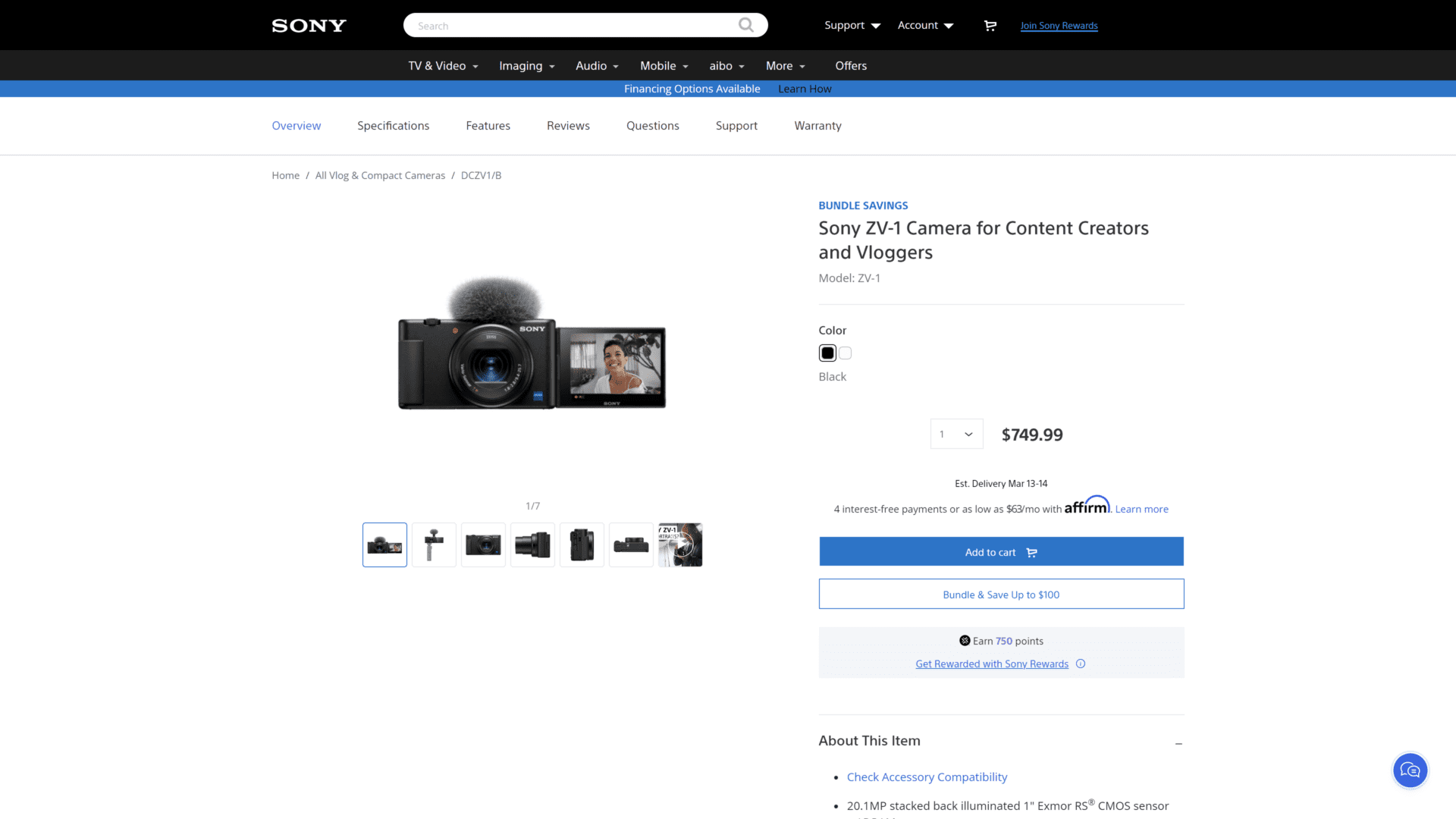
Specifications
- Resolution: 20.1 MP
- Max video resolution: 4K HD
- Audio capturing: Built-in 3-capsule microphone with windscreen accessory
- Monitor: 3″ LCD vari-angle screen, touch-enabled
- Streaming: Bult in live streaming mode, can also connect via micro USB
- Dimensions: 4-1/4″ x 2-3/8″ x 1-3/4″ (105.5 x 60.0 x 43.5 mm)
- Weight: 9.5 oz (267 g)
Overview
If you’re looking for one of the best vlogging cameras for recording videos on the go, then the Sony ZV-1 should be a strong contender in your book.
This Sony camera was actually created and marketed as a vlogging camera for YouTube videos and other content creators, so the company supplemented it with useful features, starting with its compact size.
At about only 4-1/4″ x 2-3/8″ x 1-3/4″ (105.5 x 60.0 x 43.5 mm) and weighing less than 10 oz (267 g), the ZV-1 is easy to bring wherever you’re going.
And the convenience doesn’t stop at its size. This camera makes full use of every inch (which isn’t much), with buttons and controls to make recording easier. The vari-angle screen on the side offers a smooth touch and a clear liquid crystal display.
In terms of its video features, the ZV-1 carries quite a punch for its size. It can shoot uncropped 4K HD footage at 30 FPS through a premium 24-70mm F1.8-2.8 lens. A built-in ND filter prevents light from disturbing the image. And if you want to shoot in slow motion, you can do so in 1080p quality at 120 FPS.
Sadly, the ZV-1 has its fair share of flaws. For starters, you can connect it via micro USB, which is nearly phased out today in favor of USB-C. Also, the lack of a viewfinder might be a turn off for some.
4. Panasonic Lumix GH6
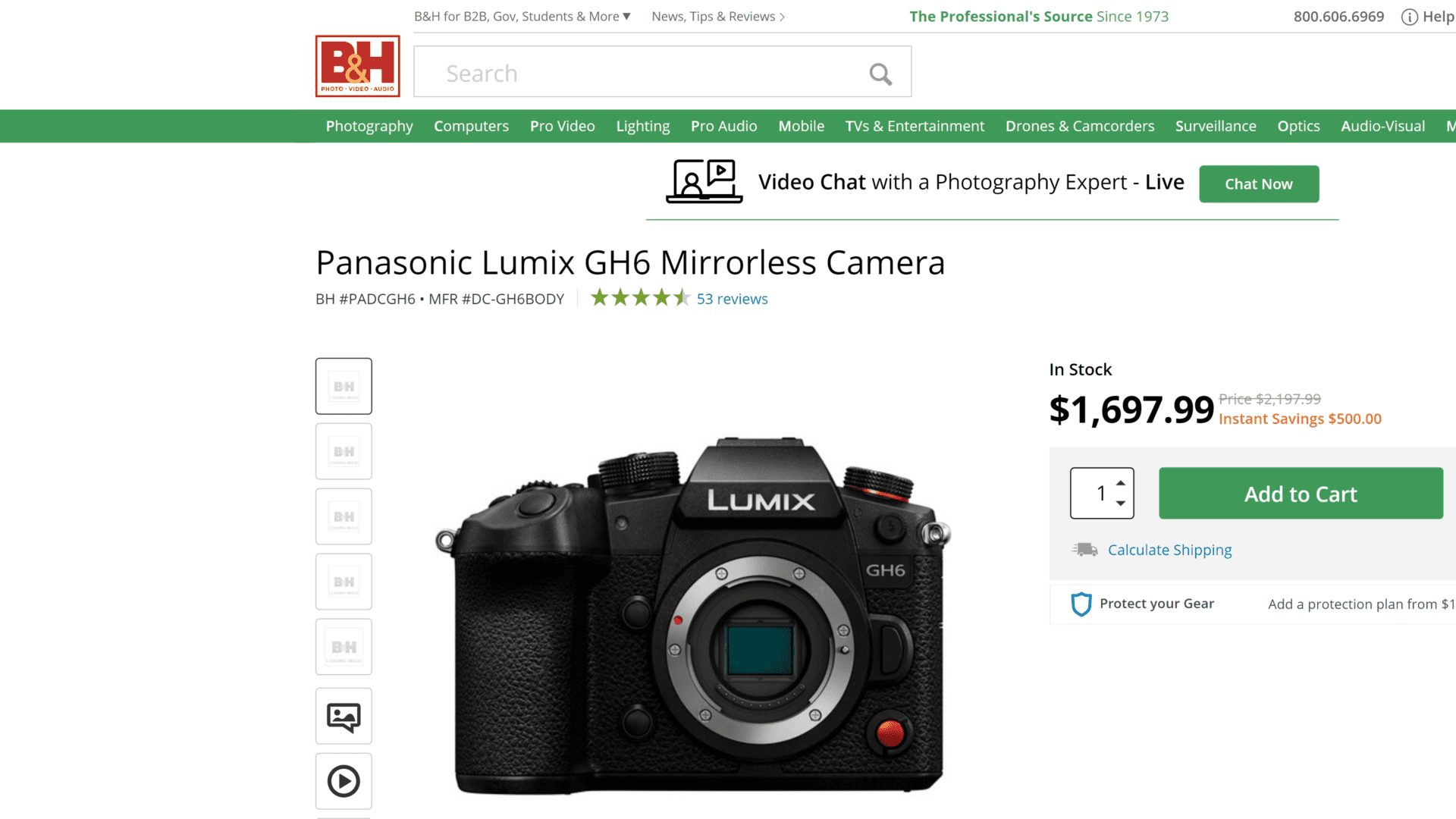
Specifications
- Resolution: 25.2 MP
- Max video resolution: 5,776 x 4,336
- Audio capturing: Built-in stereo microphone
- Monitor: 3″ free-angle tilting LCD touchscreen
- Streaming: Unavailable
- Dimensions: 5.45″ x 3.95″ x 3.92″ (13.84 x 10.03 x 9.96 cm)
- Weight: 1.8 lb (823 g) with the battery, 1.63 lb (739 g) without
Overview
Perfectionists, gather! If you’re looking for a powerful camera that allows you to take high-quality footage through a powerful lens and tune it to show all the fine details, then check out the Panasonic Lumix GH6.
Its predecessor, the Panasonic Lumix GH5 Mark II, is already an excellent all-around camera for YouTube videos. Today, we have the GH6, which improves upon almost every aspect.
The Panasonic Lumix GH6 allows you to record footage in almost 6K HD quality (5.7K, to be more precise) at 30 FPS. Thanks to its built-in fan-powered cooling system, which prevents internal heating, there’s no cap on how long your videos can be.
Professional video makers will also adore the camera’s 25.2 MP four-thirds sensor, which gives you more options in your video recording journey.
Unfortunately, one area that the Panasonic Lumix GH6 regresses in compared to its predecessor is the lack of built-in live streaming support.
Apart from that, the Panasonic Lumix GH6 may just be the best camera for YouTube if you consider its technical specifications. But in reality, it’s probably overkill for most casual YouTube video shooters. It’s also quite bulky and heavy.
5. GoPro HERO 11 Black
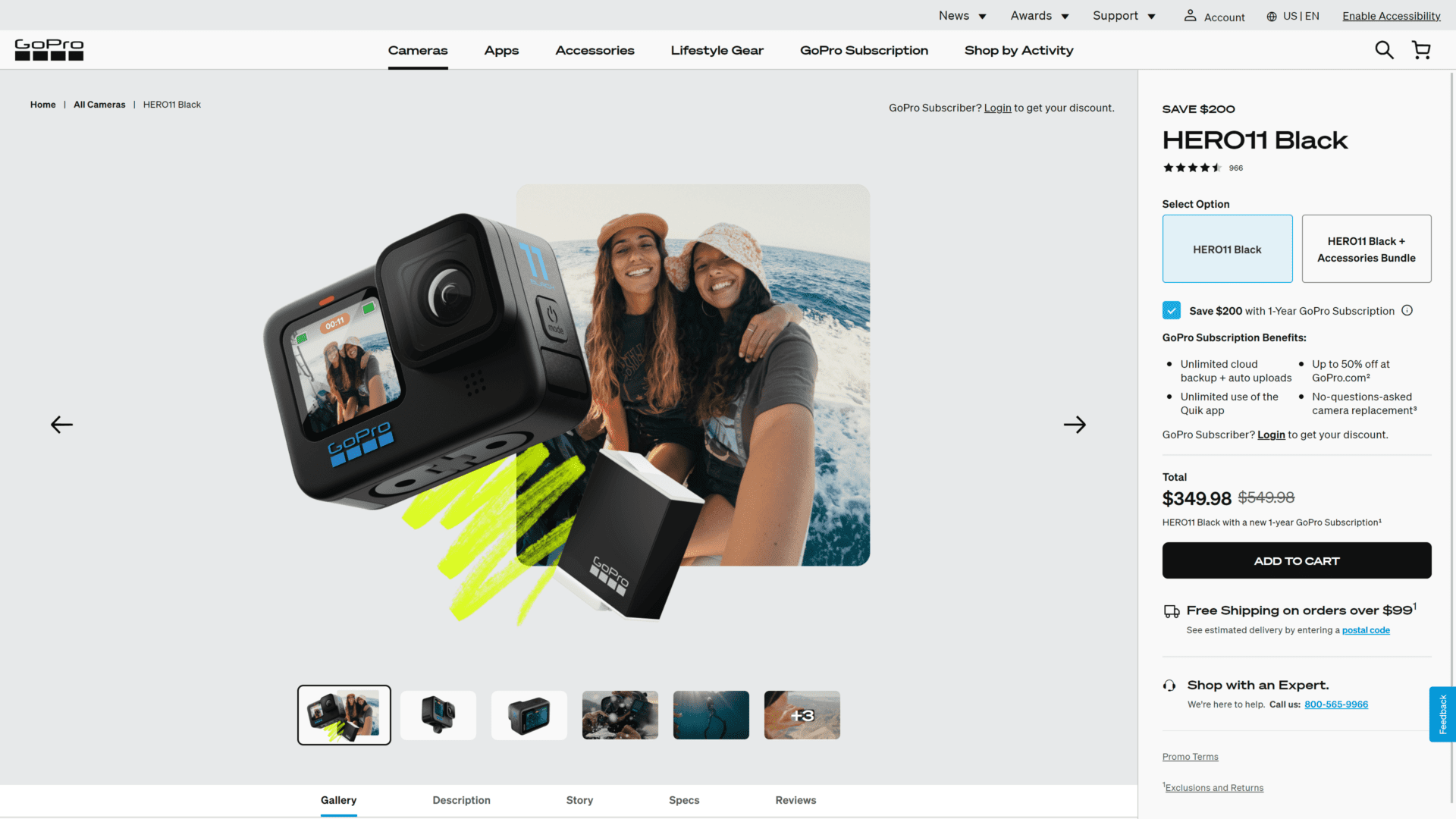
Specifications
- Resolution: 27.13 MP
- Max video resolution: 5,321 x 4,648
- Audio capturing: Built-in microphone with a 3.5mm jack for external input
- Monitor: 2.27″ LCD touchscreen on the back, 1.4″ LCD for display up front
- Streaming: Enabled
- Dimensions: 2.8″ x 2″ x 1.3″ (71.8 x 50.8 x 33.6 mm)
- Weight: 5.43 oz (154 g)
Overview
For a long time, GoPro cameras have been synonymous with shooting video while outdoors, playing sports, underwater, driving, or in other highly physical or mobile situations. The GoPro HERO 11 carries this legacy.
For starters, the GoPro HERO 11 is a compact camera. You could even classify it as a pocket camera due to its small size. But don’t mistake that for a lack of technical capability, as this camera shoots video that’s nothing short of breathtaking.
Its lens is able to shoot video at a resolution of 27.13 megapixels and a max video resolution of 5321 x 4648, or 5.3K HD at a stunning 60 FPS. And if you’re looking to capture in slow motion, you can do so in 4K at 120 FPS. You won’t find much better for something in this price range!
And given the content you’d be filming with this camera, the HERO 11 has a top-of-the-line stabilization system that makes the footage as clear as possible, whether you’re running, swimming, or driving.
Lastly, we’re always impressed by how GoPro manages to keep its superb cameras at such affordable prices. The HERO 11 is less than half the price of some of the other models here, so it’s a strong contender for the best budget camera for YouTube videos.
6. Nikon Z 30
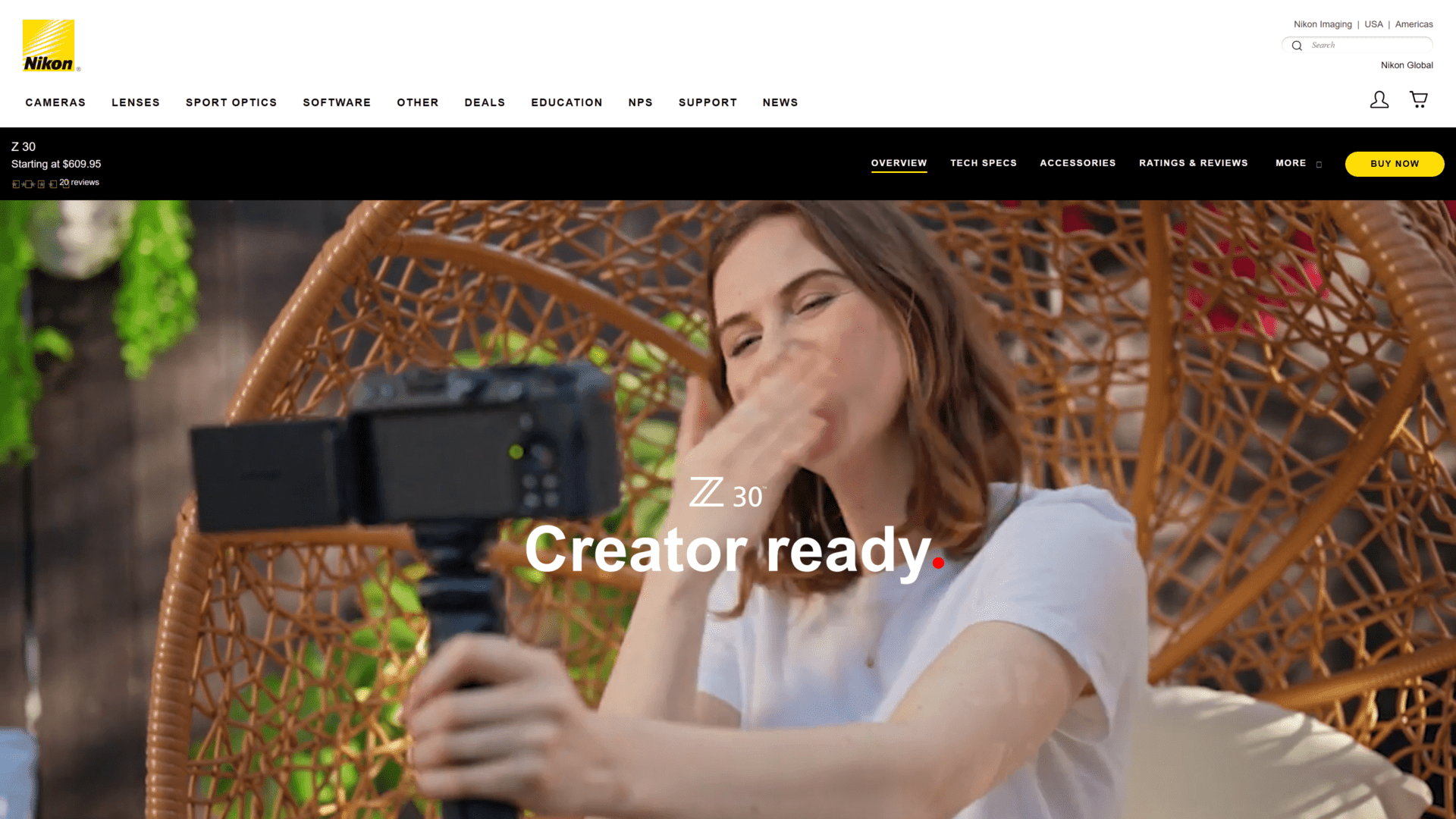
Specifications
- Resolution: 20.9 MP
- Max video resolution: 3,840 × 2,160
- Audio capturing: Built-in stereo microphone
- Monitor: 3″ LCD touchscreen
- Streaming: Enabled through USB-C
- Dimensions: 5.1″ x 2.9″ x 2.4″ (128 x 73.5 x 59.5 mm)
- Weight: 12.4 oz. (350 g)
Overview
The Nikon Z 30 is a full-on vlogging camera with an abundance of features that make your video-making journey easy from start to finish.
The Z 30 is a small and lightweight device, so it’s easy to carry around on your vlogs wherever you are, whether it’s in the next street, at a stadium, in Japan, or otherwise.
As a mirrorless camera, the Z 30 can be fitted with any of Nikon’s premium lenses, such as their flagship NIKKOR Z DX 16-50mm f/3.5-6.3 VR wide-angle or 50-250mm f/4.5-6.3 VR telephoto zoom lens.
And once you’re ready to go, start recording, and you’ll capture uncropped 4K Ultra HD footage at 30 FPS.
Nikon is also well-known for excellent autofocus, and the Z 30 embraces that with excellent face and eye recognition.
How to Pick the Best Camera for YouTube
There’s no best camera for YouTube that fits everyone’s needs, so you should be familiar with the factors to consider before buying one if you want to make a sound and informed decision.
And while there are some obvious factors that you’ve probably heard before, such as video quality and resolution, there are others that may not have crossed your mind, and they make all the difference in the world.
Camera Type
There are numerous types of video cameras, and you should know what your content type needs to narrow your search for the best camera for YouTube.
Digital Single-Lens Reflex
Digital single-lens reflex (DSLR) cameras are one of the most popular types, and it’s particularly highly praised in the YouTube community and among social media influencers.
A DSLR camera is an interchangeable lens camera, making it a versatile option for shooting YouTube videos of different styles. They also capture high-quality video in excellent resolution.
The main downside to buying a DSLR camera is, quite simply, buying it. Decent models are quite expensive, but for many professional filmmakers, the investment is worth it.
Mirrorless Cameras
Mirrorless cameras are similar to DSLR cameras, but are a bit smaller. They can also capture high-quality video, have auto-focus, and are quite portable, so they work wonders as vlogging cameras, especially among newer or inexperienced YouTube personalities who may not know their way around a more advanced YouTube camera.
Unfortunately, mirrorless cameras are also similar to DSLRs in terms of their relative priciness, but if you find yourself needing to shoot videos in fast settings or challenging lighting, then consider getting a sturdy mirrorless camera.
Point-And-Shoot
So far, this is the camera type with the least fancy-sounding name, so you can probably guess that it’s the most beginner-friendly one.
It has very similar features to DSLR and mirrorless cameras, but taken down a notch to compensate for their lower prices. Also, they’re very portable and lightweight, so they’re excellent for shooting videos on the go.
Lastly, just because point-and-shoot compact cameras aren’t expensive doesn’t mean that you won’t find success with them. They can still capture stunning videos in HD, ultra HD, or even 4K.
Sports and Action Camera
A sports and action camera focuses on capturing clear footage from high-paced scenarios, such as—as its name suggests—sports events and action-packed scenes.
Sports and action cameras are wonderful handheld, body-mounted, or fixed with a tripod, so you’ll find lots of ways to shoot in style. Since the cameras, by default, focus on in-body image stabilization, you can capture some really exciting videos.
There are a lot of accessories available for sports and action cameras. Even if you need further adjustments to your shooting set-up, you’ll likely find an attachment to help with your needs. But this can be a double-edged sword if you fall into a rabbit hole of buying accessories so often that you run out of money.
Max Video Resolution
Video quality, often measured via video resolution, is integral when making any kind of video, not just for a YouTube channel. In the early internet days, people were content with simply seeing moving pictures on their CRT computer screens. The biggest testament to this is the first YouTube video ever being available in a max video resolution of only 240p!
But as YouTube cameras became more advanced, smaller, and cheaper, higher quality became more standard. Standard HD, which is just 720p, was groundbreaking at the time. Then it got replaced by full HD, which is 1080p.
To this day, 1080p remains the standard, if not the minimum requirement, even in an affordable camera. But it’s slowly being phased out by the much clearer 4K HD.
This doesn’t mean that you should go for a 4K HD camera right away, though. 1080p will still be good for years to come. But if you have the money for it, then it’ll certainly help your video-making journey.
Frame Rate
If you go back 10-15 years, most people probably wouldn’t have much thought about the frame rate of YouTube videos, provided that the footage was 30 frames per second (FPS). After all, even movies are (and continue to be) shot in 24 FPS and still flow smoothly.
This relatively low frame rate was maintained to cut costs, and producers arrived at 24-30 FPS because it’s believed that this is the minimum frame rate for footage to appear natural to the human eye.
But when you’re on YouTube, you can really tell the difference in smoothness between a 30 and 60 FPS video. Most computer screens have been capable of displaying 60 FPS for decades, and phones are going in that direction, too. And a lot of viewers really appreciate the extra fluidity in film.
Still, in 2023, you won’t suffer a big setback if you stick with 30 FPS, but you’ll certainly have an advantage with a 60-frame YouTube camera.
Automatic Focus
Camera focus is a powerful tool for creating more cinematic videos. Funny enough, most cinema cameras don’t even have automatic focus since their target audience is professional videographers who can handle manual focus.
But for most people outside that demographic, including YouTubers, automatic focus can save you a lot of time, effort, and hassle that would otherwise go into ensuring the camera is focusing on the right object.
Autofocus works by detecting eyes or faces, predicting the rest of the person, and slightly blurring the surroundings. And if your videos you moving around a lot, you should look for a camera that tracks these movements and adjusts the focus accordingly.
Portability
YouTube camera portability may be crucial for you, depending on the kind of content you produce. For example, if you make sports videos, travel content, or on-the-go vlogs, then you’ll need a compact camera that’s portable enough for you to carry around without much hassle.
In contrast, if you shoot stationary videos in your house or backyard, for example, then you won’t need much portability. Instead, you can go for a bigger camera and fix it on a tripod for stability.
Just remember, if you’re going for a portable camera, make sure it maintains excellent video quality throughout the journey. Bonus points if it has stabilization features to make up for the camera shake.
Stabilization
Again, this is another feature that you might not necessarily need depending on your content.
If your video-making process involves a lot of moving around (for example, if you’re a sports or travel channel), then you might struggle a lot with a camera shake that ruins the viewing experience for your fans.
Thankfully, you can make it much more pleasant with built-in stabilization, also known as in-body image stabilization, which detects movements and automatically compensates for the wobble it might experience.
Even if you’re using a budget camera that doesn’t have automatic stabilization, you can buy a separate camera stabilizer that uses gimbal technology to keep your device level.
Battery Life
As a general rule, more powerful cameras tend to have a shorter battery life, which is expected since they are usually more power-intensive. Similarly, small and pocket cameras also often have much smaller batteries; thus, a shorter battery life.
This is unfortunate as cameras are already notorious for having a relatively short battery life, and they’re infamous power leeches in many mobile phones.
So consider the type of content you make when filtering cameras based on battery life. If most of your content involves sitting down in one place, you might not need a powerful battery all that much since you can film with your device plugged into a power source.
In contrast, if you often film on the go, then you obviously need more battery life. Consider that if you want to produce a 10-minute video, you might need to take footage for 30 minutes or more, for example.
Audio Quality
Most cameras have a built-in microphone with varying audio quality. Look for sound samples that demonstrate the camera’s mic clarity and see if you’re okay with it.
But note that even if a good camera doesn’t have the best sound capabilities, you can still complement it with an external microphone input.
That’s something many people do nowadays as an external microphone can be quite cheap and easily portable. All you need is a small clip to attach the mic to your shirt’s collar to film easily on the go. And if your set-up is fixed indoors, then you can buy a much more powerful sound system with a professional mic.
Live Streaming
Live streaming is as popular as ever nowadays, and many YouTubers do it on the side as a way to build a stronger bond with their fans and make a little extra cash. So, if you’re planning on live streaming on your YouTube channel, consider getting a camera that supports it.
But even if your camera doesn’t support live streaming, you could do it with the right software. It’s an extra step that you might not want to take, especially if you plan on going live regularly.
Cameras Used by Famous YouTubers
Before we finish, let’s look at the cameras used by some of the most famous YouTubers. After all, their setups undoubtedly played a huge role in netting them millions of subscribers, and it’s always good to take inspiration from successful people.
Besides, these influencers can afford any camera they want, so it’s interesting to see what they choose.
PewDiePie
Felix Kjellberg, better known as PewDiePie, had the most subscriptions of any YouTubers until just a few years ago. For much of his recent career, he relied on the Canon XA11 as his main vlogging camera. He also had the much more portable Canon PowerShot G7 X Mark II and used it from time to time.
MrBeast
Jimmy Donaldson, aka MrBeast, is currently the most subscribed individual YouTuber, and he’s been on that track for years. He uses some of the best cameras for his videos, including a Sony FDRAX53/B 4K HD, a Canon EOS 1DX Mark II, a GoPro HERO 7, and a Canon PowerShot G7 X Mark II.
KSI
Olajide Olayinka Olatunji, or KSI, is primarily known for his gaming content, but he also posts vlogs occasionally, mainly filmed with his Panasonic Lumix GH5 or Canon EOS 70D DSLR.
Frequently Asked Questions
Do I Need a 4K HD Camera or Is Full HD Enough?
A 4K HD camera is certainly a massive improvement over full HD, but if you can’t afford 4K or your content just doesn’t need it, then it shouldn’t hurt your channel, as 1080p is still very popular.
Keep in mind that 4K will eventually phase out full HD and become the new standard, just like the latter phased out 720p. Similarly, 8K HD will also replace 4K in the future, though that’s too far from now to consider for most people.
Can I Film YouTube Videos on My Phone Camera?
If you have a mobile phone with a good camera, such as a Google Pixel, an iPhone, or a high-end Samsung phone, then you can certainly try uploading a couple of videos with your mobile camera and see how your audience takes to it.
You’ll rarely receive negative feedback if you use a high-end mobile phone or even a cheap camera since not enough people will pay attention to the fine details, but having a dedicated camera for YouTube videos is a big step towards improving your video quality, and you’ll likely receive appraise once you upgrade.
Final Words
Finding the right camera to film your YouTube videos is absolutely essential, but remember that video quality is only secondary to what is being filmed. In other words, you’ll still attract fans through your content and nothing else, but it’s always important to present it in the best and most entertaining fashion.
But consider the type of content you post before looking for a camera. Overall, we found the Canon PowerShot G7 X Mark III to be one of the most powerful cameras for YouTubers, though it barely edges out other strong candidates like the Sony ZV-1 and the Panasonic Lumix GH6.


